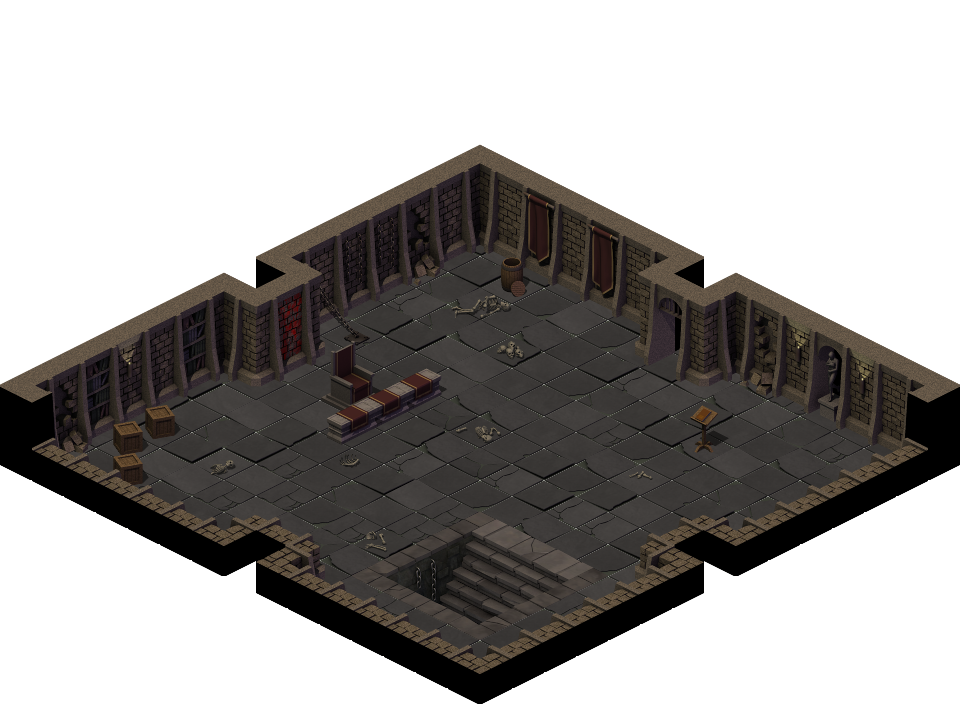@dgengin Just a quick notice, the upstream repository for FLARE is now located at https://github.com/flareteam rather than https://github.com/clintbellanger. So, for the future pull from https://github.com/flareteam/flare-game
Edit regarding the issue with the offsets, I'm not sure exactly how it works. But, at least for drawing the Stairs assets of Flare, we got it working before, and the Stairs have offset x=0, y=48.
<tileset firstgid="241" name="stairs" tilewidth="256" tileheight="256">
<tileoffset x="0" y="48"/>
<image source="stairs.png" width="1024" height="256"/>
</tileset>We handle offsets as follows.
// Draw draws the image representation of the map to the view image.
func (view *View) Draw() {
for _, layer := range view.layers {
if layer.Name == "collision" {
continue
}
for row := 0; row < view.rows; row++ {
for col := 0; col < view.cols; col++ {
gid := layer.GetGID(col, row)
tile, ok := view.tileset[gid]
if !ok {
continue
}
sr := tile.Bounds()
tileRect := view.GetTileRect(col, row, sr)
tileRect = tileRect.Add(tile.Offset) // <<< --- here the offset of the tile is added to the target drawing rectangle.
tileRect = tileRect.Add(image.Pt(0, view.delta))
draw.Draw(view, tileRect, tile, sr.Min, draw.Over)
}
}
}
}For an example see https://github.com/mewspring/tmx#examples

Currently, DGEngine is loading Flare's animations using the original texture rects and offsets converted to DGEngine's format.
examples:
Warrior animation:
https://github.com/dgengin/DGEngine/blob/master/gamefilesflare/level/player/Warrior/cel.json https://github.com/clintbellanger/flare-game/blob/branch1.08/mods/fantasycore/animations/enemies/skeleton.txt
item drop textures:
https://github.com/dgengin/DGEngine/blob/master/gamefilesflare/level/item/dropTextures.json https://github.com/clintbellanger/flare-game/blob/branch1.08/mods/fantasycore/animations/loot/
Town tileset:
https://github.com/dgengin/DGEngine/blob/master/gamefilesflare/level/data/grassland.json https://github.com/clintbellanger/flare-game/blob/branch1.08/mods/fantasycore/tilesetdefs/tileset_grassland.txt
Level tilesets are rendered correctly with the same code that draws Diablo's tilesets.
Level objects aren't. The reason is simply that I don't quite understand how they're applied in Flare so that I can figure out the best way to update DGEngine's code to support it.
Flare's drawing code is in (I think):
https://github.com/clintbellanger/flare-engine/blob/branch1.08/src/MapRenderer.cpp
One difference between Flare and DGEngine is that we add offsets and they subtract offsets. I added the following property to invert the offsets when loading Flare's resources so as to keep the code the same for both:
DGEngine's code that positions level objects is here:
https://github.com/dgengin/DGEngine/blob/master/src/Game/LevelObject.cpp
This code will make it closer to what I think flare is doing:
This issue is to help figure out how the above function should be changed to make flare's game objects animate correctly.
With the correct code in place, the Skeleton's feet shouldn't move when animating the player.